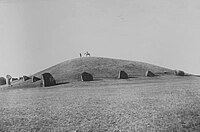Tagar culture
Arzhan culture, Karasuk culture | |
| Followed by | Tesinsky culture, Tashtyk culture |
|---|---|
The Tagar culture.
History

The Tagar culture was preceded by the
From the 2nd century BCE, the Tagar period was succeeded by a period Hunnic influence linked to the rise of the Xiongnu. The "Tesinsky culture" was a culture of the Minusinsk basin, from the 1st century BCE to the 1st century CE.[8] The Tesinsky culture was at the junction between the Tagar culture and the culture of the Xiongnu and the Xianbei, and artistic evolutions can be traced to that period.[9]
The Tashtyk culture (1st-4th century CE) then followed.[5][3][4]
Research


The Minusinsk basin was first excavated by Daniel Gottlieb Messerschmidt in 1722. Messerschmidt and Philip Johan von Strahlenberg were the first to point out similarities between the Tagar and Scythian cultures further west. The first archaeological descriptions of the Tagar were made by Sergei Teploukhov. His periodization have formed the basis for later research.[5]
Characteristics
The Tagar lived in timber dwellings heated by clay ovens and large hearths. Some settlements were surrounded by fortifications. They made a living by raising livestock, predominantly large horned livestock and horses, goats and sheep. There are evidence of farming with evidence of irrigation.[5]
The Tagar produced animal art motifs (
Perhaps the most striking feature of the culture are huge royal kurgans fenced by stone plaques, with four vertical stelae marking the corners. Burials from the early Tagar period are characterized as single burials. In the later Tagar period, collective burials become more common. This has been interpreted as a sign of social evolution in Tagar society.[5]

Physical characteristics
The Tagar people have been the subject of numerous studies by
Genetics
In 2009, a genetic study of ancient
In 2018, a study of
A genetic study published in
A subsequent genetic study in 2020 modeled the Tagar specimens as deriving around 70% ancestry from the Sintashta culture, 25% from Ancient Northeast Asian (ANA) Baikal hunter-gatherers, and 5% from the Bactria–Margiana Archaeological Complex.[15]
-
Salbyk kurgan, the largest tumulus of the Tagar culture
-
Salbyk kurgan reconstruction.[16]
-
Salbyk kurgan megalith
-
Evolution of bronze knives, from the Karasuk culture to the Tagar culture
-
Horse accoutrement
Notes
References
| Bronze Age |
|---|
| ↑ Chalcolithic |
| ↓ Iron Age |
- ^ PMID 30235269.
- ISBN 978-0521543828. Retrieved February 17, 2015.
- ^ S2CID 21347353.
- ^ Encyclopædia Britannica Online. Encyclopædia Britannica. Retrieved February 15, 2015.
- ^ a b c d e f Damgaard et al. 2018.
- ISBN 978-1-139-78938-7. "The Dinlin are considered to have been part of the Tagar Culture and are mentioned in the written sources as being among the acquired "possessions" of the Huns (Mannai—Ool 1970: 107; Sulimirski 1970: 112)."
- PMID 30235269.
The Tagar population had a mixed mtDNA pool dominated by Western Eurasian haplogroups and subgroups (H, HV6, HV*, I, K, T, U2e, U4, U5a, and U*) and, to a lesser degree, Eastern Eurasian haplogroups (A*, A8, C*, C5, D, G2a, and F1b). The Tagar population showed a similar mtDNA pool structure to those of other Iron Age populations representing the "Scythian World." We observed particularly high similarity between the Tagar and Classic Scythians from the North Pontic region. Our results support the assumption that genetic components introduced by Bronze Age migrants from Western Eurasia contributed to the formation of the genetic composition of Scythian period populations in Southern Siberia.
- ^ "Hall 31. Tesinsky culture exhibit". State Hermitage Museum.
- ISSN 2712-8202.
- S2CID 213480715.
- PMID 33157037.
- .
- PMID 30235269. "According to the results of Unterlander et al. [4], East Eurasian mtDNA components in the Western Eurasian steppe belt increased during the Early Iron Age .... The observed reduction in the genetic distance between the Middle Tagar population and other Scythian-like populations of Southern Siberia (Fig 5; S4 Table), in our opinion, is primarily associated with an increase in the role of East Eurasian mtDNA lineages in the gene pool (up to nearly half of the gene pool) and a substantial increase in the joint frequency of haplogroups C and D (from 8.7% in the Early Tagar series to 37.5% in the Middle Tagar series)." .... "We observed differences in the mtDNA pool structure between the Early and the Middle chronological stages of the Tagar culture population, as evidenced by the change in the ratio of Western to Eastern Eurasian mtDNA components. The contribution of Eastern Eurasian lineages increased from about one-third (34.8%) in the Early Tagar group to almost one-half (45.8%) in the Middle Tagar group."
- ^ Damgaard et al. 2018, "The southern Siberian Tagar show unequal ancestry contributions from Bronze Age herders (83.5%) and southern Siberian hunter-gatherers (7.5%), as well as an additional contribution of Mal’ta (MA1 individual)-like ancestry (9%), indicating differences in the sources of hunter-gatherer admixture across the Sakas.".
- S2CID 214725595.
- S2CID 132181643.
- S2CID 213480715.
External links
- "Тагарская культура (Tagar culture)" (in Russian).
- The Tagar culture is presented in Hall 31 of the State Hermitage Museum (3D Tour).
Further reading
- Damgaard, P. B.; et al. (May 9, 2018). "137 ancient human genomes from across the Eurasian steppes". S2CID 13670282. Retrieved April 11, 2020.




![Salbyk kurgan reconstruction.[16]](http://upload.wikimedia.org/wikipedia/commons/thumb/0/08/Salbyk_kurgan_reconstruction.png/200px-Salbyk_kurgan_reconstruction.png)

![Bronze weapons of the Tagar culture, Krasnojarsk, Russia, 7th-5th century BC.[17]](http://upload.wikimedia.org/wikipedia/commons/thumb/1/1c/Museum_f%C3%BCr_Vor-_und_Fr%C3%BChgeschichte_Berlin_007a.JPG/178px-Museum_f%C3%BCr_Vor-_und_Fr%C3%BChgeschichte_Berlin_007a.JPG)


